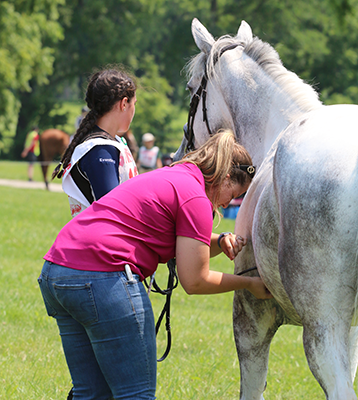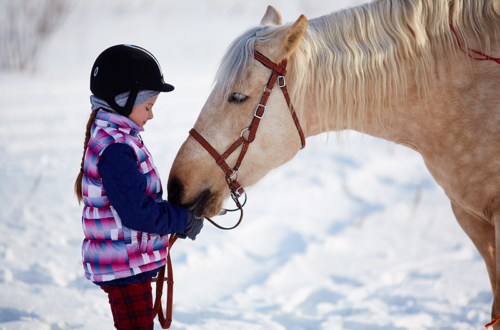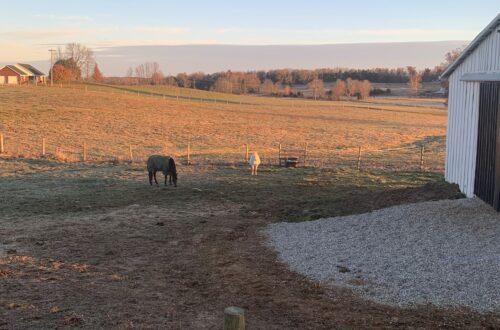
Taking Your Horse’s Vital Signs
By Mary Dennis, DVM, and Connie Jehlik, USPC Instruction Services Director
What does “take your horse’s vital signs” mean? Vital signs can also be referred to as “TPR” or “temperature, pulse, and respiration.” You might be thinking, “My horse is sick. He won’t eat or drink, and he looks terrible. Aren’t those enough signs for my vet?”
Just like when you go to the doctor, a member of the medical staff takes your pulse (heart rate), temperature, and listens to your breathing (respiration), it is the same thing for your horse or pony. You need to know what “normal” or “at rest” is for your horse’s temperature, pulse, and respiration so that when your horse or pony is sick or in need of a veterinarian, you can tell your veterinarian right away (typically on the phone) what your horses vital signs are. This helps your vet be able to quickly know how urgent the situation might be, because knowing if the TPR signs are abnormal and what they are can give him or her a lot of information.
Measuring Vital Signs
How do you measure each of these vital signs? First, like everything, it does take a little practice and learning to do this when your horse or pony is quiet (at rest) will help when the situation changes, and he won’t stand still or quietly.
TEMPERATURE: Begin with taking the horse’s temperature. First, we discourage the use of mercury thermometers anymore as they can easily break, and mercury is poisonous to you and the horse. Digital thermometers are really easy to use nowadays, so ensure you have one of those on hand.
The average temperature for a horse or pony is usually between 98.5-101 degrees Fahrenheit. Using a digital thermometer, make sure the thermometer is turned on by pressing the button. Stand at the side of the horse’s hindquarters, gently lift his tail, and insert the thermometer into the rectum about 2-3 inches, and hold it in place until it beeps, indicating that the maximum temperature was reached. Remove the thermometer and read the temperature on the digital display. Clean the thermometer with soap and water or rubbing alcohol after each use.
PULSE/HEART RATE: Next, learn to take the pulse, or heart rate, of your horse or pony. The normal range should be between 30-45 beats per minute. There are different places on a horse’s body where a pulse can be easily felt, where an artery runs just under the skin. You will need to find the best place that works for you, and you will need to practice so you become proficient at finding a horse’s pulse. For me, I have always liked using the facial artery that is located underneath the mandible or cheek area. The artery is the size of a pencil, and it feels like a large spaghetti noodle under the skin. It is hard to feel the pulse if a horse is chewing or moving his head, so have someone hold the horse’s head, and do not let him eat.
Using two fingers, find the facial artery and push it up against the horse’s jawbone so that you can feel the slow pulses running through it. Count the pulses for 15 seconds and then multiply by 4, or count for 30 seconds and multiply by 2, to get beats per minute. To help learn this method, I suggest practicing after your horse has been exercised, as the pulse will be higher and easier to feel. Once you become good at taking his pulse here, then when he is sick or injured, you can then immediately take it as needed.
A digital pulse, found on the back of the fetlock joint, is another place to find a pulse on an equine. This is called the digital pulse. You can find the artery running toward the back on each side of the fetlock over the sesamoid bones. There is an artery on the inside and outside. To feel the pulse, it is like taking your own pulse at your wrist. The digital pulse is much harder to find than the facial artery but can be very obvious in a foundering horse.
To take the heart rate, you will need a stethoscope. The easiest place to hear the heartbeat is on the left side, inside the elbow, just in front of where a girth would rest. You should be able to hear a “lub-dub,” which makes one beat. The USPC C Manual has a great diagram on page 197.
RESPIRATION: Lastly, take his breathing or respiration rate. The normal range falls between 8 and 16 breaths per minute. This can be done easily by either watching the nostrils (as your horse breathes) or watching his flank area as he breathes and counting the breaths for 15 or 30 seconds, and then multiply by 4 or 2, as you did with the pulse, to get breaths per minute.
Remember, anytime a horse is in pain or sick, his TPR is the first thing you should check so you can share this information with your veterinarian.





